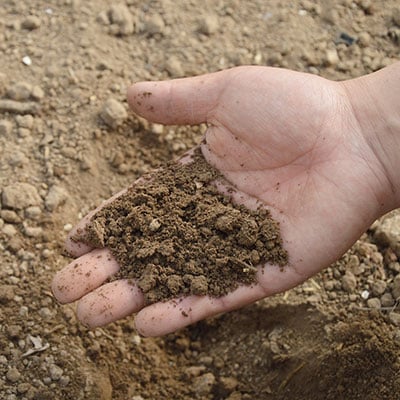
Whether you’re growing a bountiful vegetable garden for your own produce or want to have beautiful flowers surrounding your home all year round, the key to your garden’s success will significantly be impacted by the kind of soil it’s growing in. Simply put, the healthier the soil is, the healthier your garden will be.
Though some of the best ways to enhance the nutrients of the soil is to add compost, fertiliser, manure, and other environmentally friendly nutrients, it’s important to determine what kind of soil you already have, as well as its properties before adding more to it.
Types of Soil
Soil is naturally rich in three different types of mineral particles: clay, sand, and silt -- each behaves differently and requires different needs (water, sun exposure, etc.). The texture of the soil changes as the relative percentage of each of these particles in the soil varies:
- Clay
Though this soil has the least amount of water and air between particles, a soil mixture that contains at least 50% clay actually holds water quite well once wet. It also drains, dries out, and warms up slowly, but clay soil is known to be very fertile. If you live in an area that tends to experience hot dry seasons, clay soil may be the most beneficial as it retains water well. - Sand
Unlike clay soil, sand soil has the largest pores between particles. However, even though it is not as fertile as clay and has a more difficult time retaining moisture, it still holds some benefits for growing vegetables. - Silt
With the particle size between that of clay and sand, silt shares similar qualities of clay, such as excellent draining capabilities, but has a much larger particle size so it is able to hold more nutrients than sandy soil. - Loam
A perfect mixture of sand (40%), clay (40%), and silt (20%), loam is the ideal soil texture to have.
As previously mentioned, adding organic matter and other compost material to your garden’s soil will improve its texture, able to hold more water and nutrients. In addition to becoming more fertile, organic matter such as leaves or grass clippings will also reduce the difficulty of the soil and drain water in a more efficient manner.
But how exactly can you determine whether or not the soil in your garden has what plants require in order to grow and flourish? By examining the soil itself with a soil test.
Testing Your Soil
There are several ways you can determine what kind of soil you have in order to figure out what to add or subtract from it. Keep in mind that the texture of the soil will only change if you completely excavate the soil and replace it. Below are a few soil tests you can try yourself at home:
- Ribbon Test
This is one of the simplest ways to test the texture of your soil. Roll a Ping-Pong sized ball of moist soil into your hand, and then squeeze the soil between your thumb and fingers in the palm of your hand to make a ribbon with the soil. If you are unable to form a ribbon, this likely means that the soil contains at least 50% sand and needs more clay. In some cases there may be less than 50% sand and this can be determined by how long the ribbon is before breaking. The longer the ribbon is before breaking, the more clay particles it contains. - Jar Test
Using a tall wide mouthed jar, add 1 inch of dry, crushed garden soil and 1 teaspoon of a dispersing agent (e.g.: Calgon or table salt), filling the jar ⅔ of the way with water. Shake the jar well and then allow the contents to settle for a few minutes. During this process, the sand will be the first to settle at the bottom after 1 to 2 minutes. After 4 to 5 hours the silt should be settled. And finally, the clay should settle after a few days. Once all of the contents have settled, measure the depth of each layer of soil and calculate the percentage of each. - PH Test
In addition to testing the texture and components of the soil, it’s important to test the pH level as well. To test the alkaline level, add a few drops of vinegar to 1 tablespoon of dried garden soil. The soil will begin to fizz if the pH is above 7.5 as the free carbonates in the soil naturally react with the acid at a pH of 7.5 or higher. The acidity of the soil can be tested by adding a small amount of baking soda to 1 tablespoon of wet soil. If the pH is less than 5.0 then the soil will start fizzing, indicating that the soil is very acidic. Ideally, the pH for a majority of plants will fall between 5.5 and 7.5, but there are a few plants that will prefer conditions outside of this range. Depending on where the soil lands on the pH scale, you can either add sulphur (for alkaline soil) or limestone (for acidic soil) until you reach the appropriate balance.
Performing multiple soil tests like the ones mentioned above will help you determine what you can and cannot grow in your garden.




